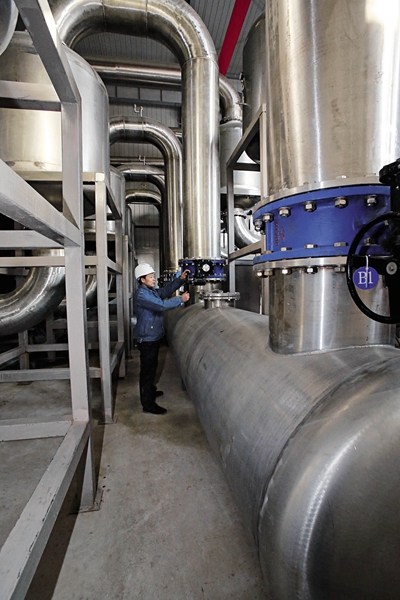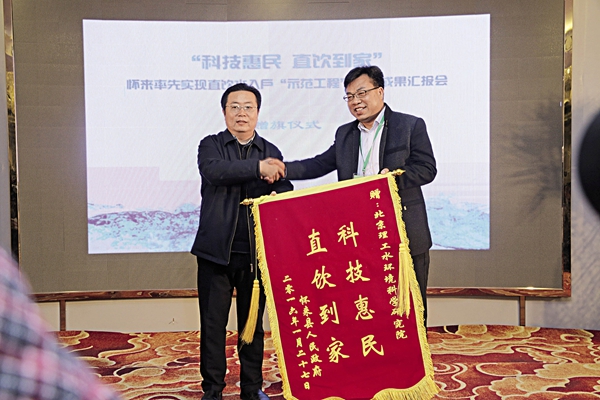Potable Tap Water Imminent in China?
By XIA YUAN & LUO YUANJUN
THE water treatment method most commonly used today was formulated in Belgium in 1902. Entailing the four steps of flocculation, sedimentation, filtration, and disinfection, it played an important role in facilitating economic and social development in the last century. Since the 1980s, when chemical fertilizer began being used and promoted in China, the country’s water resources have become polluted to varying extents. The traditional method of water treatment can no longer neutralize today’s complicated contaminants. In some areas of China, activated carbon and ozone are used for water treatment. But this approach is costly and also fraught with post-treatment problems.
Because potable tap water is not available, barreled or bottled drinking water, and home or residential community water treatment systems have become popular in Chinese cities and in certain rural areas. This water is purified using filters, but producing one ton of drinking water consumes four to six tons of fresh water, and lots of electricity. It is hence an extravagant method in China, where water is alarmingly scarce. As this process also generates plastic waste, such as filters, it is also environmentally detrimental. Therefore, finding a new water treatment technique that can produce low cost, quality drinking water is now imperative.
Application of New Techniques
“Before when I used to boil tap water at home, it always created large limescale deposits. Now there are hardly any, because the quality of tap water is almost equal to that of barreled drinking water. I use boiled tap water to make tea now,” said a resident of Huailai County of Zhangjiakou City, Hebei Province.

A technician checks the water treatment equipment developed by the School of Scientific Research on Water Environment of Beijing Institute of Technology at a water works in Huailai County.
Today, more than one million residents of Huailai County of Hebei Province, Puxian County of Shanxi Province, and Changying Town of Beijing’s Chaoyang District can enjoy potable tap water at home, thanks to successful pilots of a new technique. According to a third-party test organization, the quality of water it produces meets domestic standards as regards hygiene, and also contains beneficial mineral substances and trace elements. It surpasses European and American standards. Moreover, the new technique can potentially reduce the investment needed to set up and operate water works. As it will as well conserve fresh water and curb contaminants, it has won delighted commendation from local governments and residents.
The project to provide quality tap water in Huailai County was first launched in September, 2014 and completed in October 2015. It gives residents of Huailai County access to safe, quality mineral water at home. With a total investment of RMB 42 million and a planned water supply of 30,000 tons per day, the project can serve as many as 200, 000 people. It will consequently bring great social benefits as well as economic returns.
The project will enable Huailai County to save about 450,000 tons of fresh water, about 18 million Kwh of electricity, and achieve a 450,000 ton reduction in sewage discharges every year. More important, the supply of quality water will improve public health, so reducing medical expenditure. It is also conducive to lower social and economic costs as regards changing water lines and pipes. After implementation, the local government’s goals of 10 to 15 percent of energy conservation and emission reduction per year can be achieved.
“It took just one year to carry out the project of providing potable tap water in Huailai County,” Vice Mayor of Zhang-jiakou City and Secretary of the CPC Huailai County Committee Guo Ying remarked. “It serves as a valuable example of upgrading water supply techniques and comprehensively improving the quality of tap water in urban areas.” Guo added: “The project represents technological innovation, and also a great example of the integration of production, studies, scientific research, and practical application. It embodies the painstaking efforts of many enterprises and experts, and its application will provide precious experience and have a profound influence on urban water treatment in the future.”
Physical Water Treatment Process
Is there a method of large-scale water treatment that does not use chemicals? After studying the formation of natural mineral water, researchers at the School of Scientific Research on Water Environment of Beijing Institute of Technology (BIT) concluded that an artificial environment that resembles a natural geological structure can be created to purify fresh water while maintaining its mineral contents.
“We are learning from nature, and can now enable city dwellers to enjoy quality mineral water at home,” Director of the School of Scientific Research on Water Environment of BIT Yang Changyou said.

Sun Xiaohan, head of Huailai County, presents to Yang Changyou a silk banner in appreciation of the successful development by Yang’s team of a new water treatment technique.
Over the past decade, BIT has cooperated with Beijing Tai He Jie Yuan Technology Development Co., Ltd. in carrying out research on a new water treatment technique that will provide potable tap water in urban and rural areas. Technical personnel have now developed a system that can replicate the natural process of producing mineral water. It entails activating the water, or changing its molecular structure to make it beneficial to health, removing contaminants, balancing the minerals in the water, and physically disinfecting it. Through various innovations and practices, the team has achieved optimum results. Owning as it does the complete intellectual rights property, this technique has been awarded many patents. The project has been evaluated and granted Ministry of Housing and Urban-Rural Development certification, won support from the Ministry of Science and Technology and been listed as a key project in Hebei Province.
The new technique is a physical process completely different from traditional water chlorination. According to the School of Scientific Research on Water Environment of BIT, as a brand new concept, this water treatment technique is highly efficient and conducive to environmental protection. It is therefore the ideal choice for water treatment in both urban and rural areas of China. It is also suitable for large-scale applications that will enable the majority of residents to enjoy potable tap water at home.
So far, more than one million people in China have access to tap water treated through this technique. According to relevant experts, this method has the following advantages:
First, because it meets the need for quality water, it has improved people’s lives. The technique is flexible because it features different designs for different water resources that have different contaminants.
Second, it adopts new methods rather than that of traditional water chlorination to render water germ-free. The new method not only kills certain algae and microbes in the water, but also keeps the water clean for at least 10 days. In addition, its high negative oxygen and dissolved oxygen content helps clean and protect water pipes, so guaranteeing that the quality of the water throughout the whole treatment system will remain stable and non-toxic. In other words, the new method resolves the drawbacks of water chlorination. It hence constitutes a global breakthrough in water treatment.
Third, water treated with the new technique can gradually remove the dirt and microbes that cling to the inner walls of water pipes, and contaminants can be flushed out through these pipes. It, therefore, cleans both water pipes and lines within a certain time. Meanwhile, the water’s high content of negative oxygen ions forms a protective layer of negative oxygen on the pipes’ inner walls, so preventing the formation of contaminants in water lines.
Fourth, it provides quality tap water in cities, so significantly improving people’s lives. By learning the principles of how natural geological structures treat water, technicians have created a system that now supplies fresh, pure, safe water to urban residents.
In order to comprehensively improve the water quality of Zhangjiakou City, the local government has announced a project to provide potable tap water at locations in Chongli County for the coming 2022 Winter Olympics, one of the city’s Olympic projects. The local government has signed a cooperation agreement with China Aerospace Construction Group Co., Ltd. and BIT to set up the Zhangjiakou Water Affairs Group Company. It is expected to carry out the project to make potable tap water available throughout the whole city, so benefiting its residents.
“Huailai County is the first place in the country to make drinkable tap water available at home. And the project benefits not only people, but also the environment. It’s a good test for Zhangjiakou City in its efforts to provide quality drinking water during the 2022 Winter Olympics. By that year, we plan to make potable tap water available throughout the city, not only guaranteeing the supply of quality drinking water during the Winter Olympics, but also benefiting our 4.5 million residents,” Guo Ying said.
Services
Economy
- Studying the Real Forces Driving Innovation Is Vital for China
- Chinese Growth, A Boon for the Dutch Economy
- Sino-U.S. Trade Ties: Steady Progress in Cooperation
- Making the Food Safety City Brand Construction a Focus - The Seventh Weihai International Food Expo opens
- Expand Trade and Upgrade FTA – An Exclusive Interview with New Zealand's Ambassador to China
